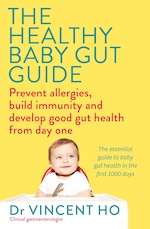A good diet in the early years of life can make a real difference to the health of a child.
A child’s gut passes through three phases as they develop:
- a development phase occurs from three to 14 months
- a transitional phase occurs from 15 to 30 months
- a stable phase from 31 months onwards.
The number of infant gut bacteria increases drastically with the introduction of solid foods. The transitional shift in the infant gut microbiota happens between one and two years of age; after the transitional phase the gut microbiota becomes stable and more similar to an adult’s.
What introducing solids does to your child’s gut
The process of weaning—when solid foods are introduced to your baby—typically starts at around four to six months of age and continues until the child is approximately two years old. The World Health Organization (WHO) recommends a gradual introduction of solid foods while the baby is still taking breastmilk and/or infant formula. The gold standard for breastfeeding is to feed exclusively until six months of age, so this is the ideal time to start introducing solid foods.
Generally, at around six months of age, babies begin to show interest in eating solid foods. If babies are started on solid foods too early, their digestive system will not be mature enough to handle the food. Before four months of age, their pancreatic function, small-bowel absorption and fermentation ability is underdeveloped. It is only at six months of age that the pancreas will secrete enough enzymes to digest the starches and proteins of solid foods.
At around six months of age, infants are also developmentally ready to start solid foods; they can hold their head and neck up straight, which allows food to be swallowed safely. At that age, the “tongue-thrust” reflex—where infants push out anything in their mouths using their tongue—disappears, and they should be able to reach out for food and open their mouth when offered food on a spoon.
Babies are born with significant iron stores in their livers. At six months old, the baby’s iron supply from their mother is depleted. Since human milk is quite low in iron, the baby then needs to consume either an iron-fortified infant formula or a diet of iron-rich foods, such as meats, dried peas, beans and legumes, tofu, eggs and leafy vegetables. During weaning, a baby should also be consuming vitamin-D–fortified milk, yoghurt and cereals, as vitamin D is necessary not only for building bone strength but also for the proper maturing of the gut microbiota.
Read: The best way to boost your iron levels
As solid foods are introduced into the baby’s diet, the gut microbiota begins the process of evolving from a simple environment that digests only breastmilk or formula to an environment that can digest richer, more varied foods. The introduction of solid foods triggers the change in the gut microbe community, but the gradual reduction in breastfeeding has the greatest impact on the baby’s gut microbes.
The timing of solid foods and allergies
Research has now determined the best time to introduce solid foods to reduce allergies. A research team from the United Kingdom followed a group of more than 1000 infants from birth to two years old and documented suspected allergic reactions to food. They found that the infants who developed food allergies were more likely to have been introduced to solids before 17 weeks (four months) of age. Their findings named 17 weeks as the crucial turning point. Introducing solid foods before 17 weeks appeared to promote allergies, whereas introducing solid foods after this time seemed to promote immune tolerance.
The researchers also found that continuing to breastfeed while introducing cow’s milk had a protective effect against allergies. They suspect that the breastmilk’s positive role in the baby’s immune system is even greater when the immune system is exposed to an allergen such as cow’s milk protein at the same time. It’s the perfect balance, in other words.
Multiple studies have confirmed that there is no evidence to justify a delayed introduction of solid foods after six months of age to prevent allergies in both high- and low-risk infants. Australasian Society of Clinical Immunology and Allergy (ASCIA) guidelines recommend starting solid foods at around six months of age, but not before four months. Breastfeeding your baby while introducing solid foods is also recommended. Guidelines from a number of other national allergy societies and the WHO mirror ASCIA’s recommendation.
Read: How these three habits can damage your gut health
Benefits of a diverse diet
At the end of the first 1000 days of life, when a child is two years old, they have achieved a stable gut microbiota. At that point, the effects of prior breastfeeding are no longer seen in the gut microbiota. Diet is the key to shaping the numbers and types of helpful bacteria in the gut, as well as maintaining the right balance of the different sorts of microbes.
Nutrition is critical to regulating the gut microbiota throughout life. There has been extensive research carried out on the role of diet in early life and the flow-on risk of allergy. A striking finding from the research is that eating from limited food groups during the first year of life can increase the risk of asthma and other allergies during childhood. In contrast, eating from many different food groups in the first year of life appears to reduce the risk of asthma, food allergy and food sensitisation.

This is an edited extract from The Healthy Baby Gut Guide by Dr Vincent Ho, Allen & Unwin, RRP $29.99, available now.
How helpful was this article?
Click on a star to rate it!
0 / 5. 0
Be the first to rate this post!
Dr Vincent Ho
Related posts
Subscribe
Receive personalised articles from experts and wellness inspiration weekly!


